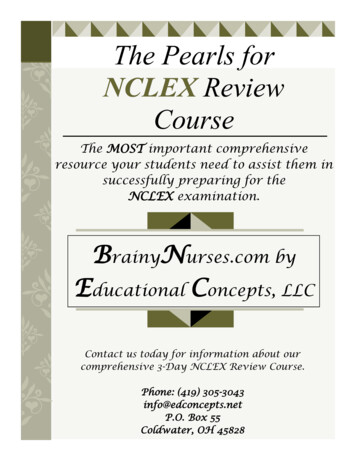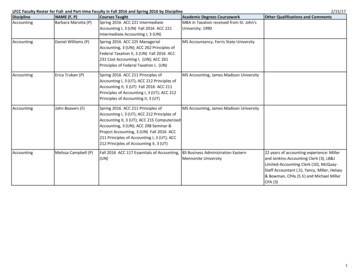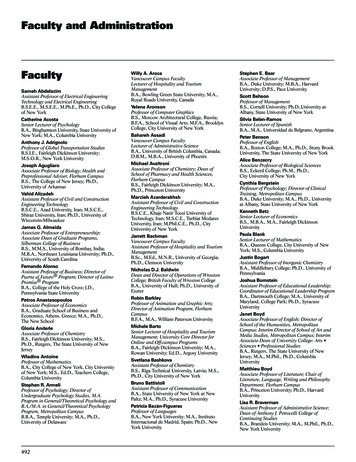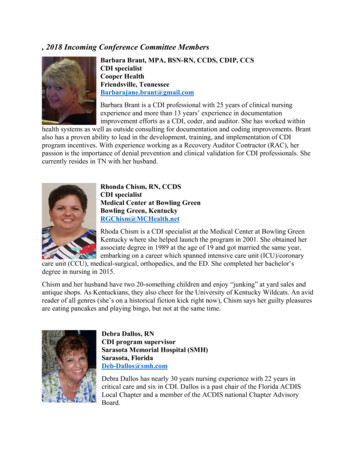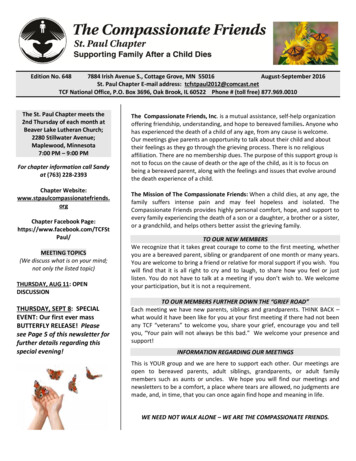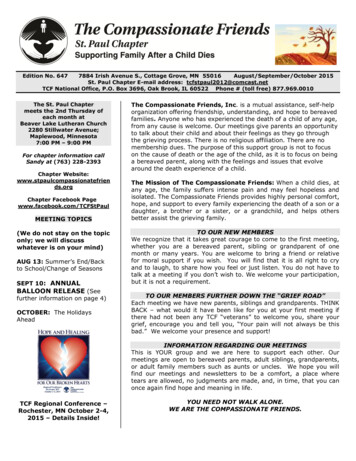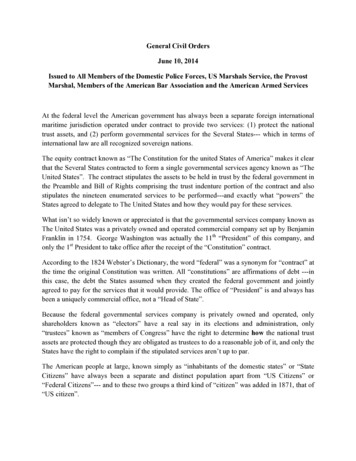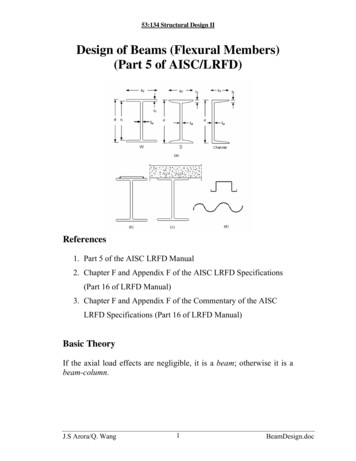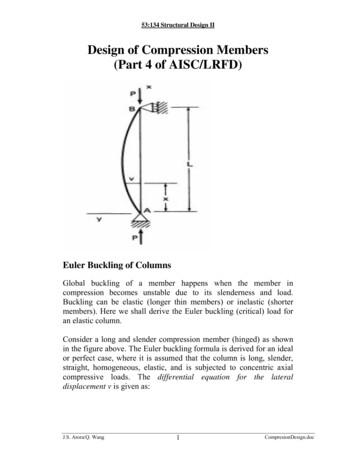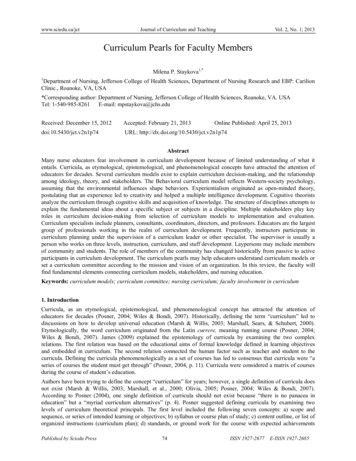
Transcription
www.sciedu.ca/jctJournal of Curriculum and TeachingVol. 2, No. 1; 2013Curriculum Pearls for Faculty MembersMilena P. Staykova1,*1Department of Nursing, Jefferson College of Health Sciences, Department of Nursing Research and EBP: CarilionClinic., Roanoke, VA, USA*Corresponding author: Department of Nursing, Jefferson College of Health Sciences, Roanoke, VA. USATel: 1-540-985-8261E-mail: mpstaykova@jchs.eduReceived: December 15, 2012Accepted: February 21, 2013Online Published: April 25, 2013doi:10.5430/jct.v2n1p74URL: http://dx.doi.org/10.5430/jct.v2n1p74AbstractMany nurse educators fear involvement in curriculum development because of limited understanding of what itentails. Curricula, as etymological, epistemological, and phenomenological concepts have attracted the attention ofeducators for decades. Several curriculum models exist to explain curriculum decision-making, and the relationshipamong ideology, theory, and stakeholders. The Behavioral curriculum model reflects Western-society psychology,assuming that the environmental influences shape behaviors. Experientialism originated as open-minded theory,postulating that an experience led to creativity and helped a multiple intelligence development. Cognitive theoristsanalyze the curriculum through cognitive skills and acquisition of knowledge. The structure of disciplines attempts toexplain the fundamental ideas about a specific subject or subjects in a discipline. Multiple stakeholders play keyroles in curriculum decision-making from selection of curriculum models to implementation and evaluation.Curriculum specialists include planners, consultants, coordinators, directors, and professors. Educators are the largestgroup of professionals working in the realm of curriculum development. Frequently, instructors participate incurriculum planning under the supervision of a curriculum leader or other specialist. The supervisor is usually aperson who works on three levels, instruction, curriculum, and staff development. Laypersons may include membersof community and students. The role of members of the community has changed historically from passive to activeparticipants in curriculum development. The curriculum pearls may help educators understand curriculum models orset a curriculum committee according to the mission and vision of an organization. In this review, the faculty willfind fundamental elements connecting curriculum models, stakeholders, and nursing education.Keywords: curriculum models; curriculum committee; nursing curriculum; faculty involvement in curriculum1. IntroductionCurricula, as an etymological, epistemological, and phenomenological concept has attracted the attention ofeducators for decades (Posner, 2004; Wiles & Bondi, 2007). Historically, defining the term “curriculum” led todiscussions on how to develop universal education (Marsh & Willis, 2003; Marshall, Sears, & Schubert, 2000).Etymologically, the word curriculum originated from the Latin currere, meaning running course (Posner, 2004;Wiles & Bondi, 2007). James (2009) explained the epistemology of curricula by examining the two complexrelations. The first relation was based on the educational aims of formal knowledge defined in learning objectivesand embedded in curriculum. The second relation connected the human factor such as teacher and student to thecurricula. Defining the curricula phenomenologically as a set of courses has led to consensus that curricula were “aseries of courses the student must get through” (Posner, 2004, p. 11). Curricula were considered a matrix of coursesduring the course of student’s education.Authors have been trying to define the concept “curriculum” for years; however, a single definition of curricula doesnot exist (Marsh & Willis, 2003; Marshall, et al., 2000; Olivia, 2005; Posner, 2004; Wiles & Bondi, 2007).According to Posner (2004), one single definition of curricula should not exist because “there is no panacea ineducation” but a “myriad curriculum alternatives” (p. 4). Posner suggested defining curricula by examining twolevels of curriculum theoretical principals. The first level included the following seven concepts: a) scope andsequence, or series of intended learning or objectives; b) syllabus or course plan of study; c) content outline, or list oforganized instructions (curriculum plan); d) standards, or ground work for the course with expected achievementsPublished by Sciedu Press74ISSN 1927-2677E-ISSN 1927-2685
www.sciedu.ca/jctJournal of Curriculum and TeachingVol. 2, No. 1; 2013and outcomes; e) textbooks, or day-to-day guide; f) course of study, or series of steps the student should complete(curricula); and g) all planned experiences.The second level attempted to explain the nature and the meaning of a curriculum by integrating the following fivecurriculum concepts: a) formal curriculum, official or written; b) operational curriculum, active in practice; c) hiddencurriculum, not acknowledged; d) null curriculum, not taught; and e) extra curriculum or teaching experiencesoccurring outside the school system (Posner, 2004). Each concept led to different interpretation and thereafterapplication of curriculum concepts (Posner, 2004). A competent educator should be cognizant of the coexistingconcepts when designing comprehensive curricula for any type of organizations.2. Curriculum-Theory ModelsThe curriculum studies started as a traditional theory intending to pass knowledge to people (deMarrias & LeCompte,1999) and were first influenced by Horace Mann and Henry Barnard. In 1893, the National Education Associationestablished the Committee of Ten to look at the curriculum process. Dominant figures in the 18th and 19th centurycurriculum development were Johann Herbart, William Harris, Stanley Hall, John Sewey, Franklin Bobbitt, HaroldRug, and Ralph Tyler. This intellectual forum for curriculum policy making, influenced the curriculum developmentduring early 20th century and the contemporary society surpassing the influence of other curriculum-regulatinggroups (Marshal et al., 2007). Marsh and Wills (2003) favored models expressing curriculum decisions, and therelationship among theoretical principles, rules, and ideology. These models were traditional, social behaviorist,experientialist, constructionist, and structure of the discipline (Posner, 2004). See Figure 1 for a conceptual model.Figure 1: Members of Curriculum Committee2.1 Traditional Curriculum ModelAccording to the traditional curriculum perspective, the purpose of education is to become a vector transmittingcultural heritage of a dominant culture (Posner, 2004). The curriculum of traditional education emphasizes a set offundamental values and skills such as respect to authority, knowledge of fundamental terms, and socially acceptednorms. Therefore, an official curriculum, representing the traditional position, selects educational objectivesreflecting the values important for the dominant culture.The traditional curriculum objectives may attempt to blend other cultures and ethnicity (Posner, 2004). The hiddencurriculum (what is not taught but objectified in behavioral expectations) may have a damaging effect on the initialaims of the traditional curriculum and may lead to judgmental support of the dominant culture’s ideology. Forexample, students who are not born in the dominant culture may face segregation based on language, skills, and othercultural or ethnic attitudes (Posner, 2004). The traditional curriculum usually includes strategies that educationalinstitutions may use to promote the values of a central culture. Dewey, a leading critic of the traditional perspective,concluded that the traditional education was a result of passive transmission of information from the old to the newgenerations (Posner, 2004). Diverse student populations attend nursing schools and higher education institutionsPublished by Sciedu Press75ISSN 1927-2677E-ISSN 1927-2685
www.sciedu.ca/jctJournal of Curriculum and TeachingVol. 2, No. 1; 2013today. Faculty members selecting the traditional model for implementation in their programs should be aware of thelimitations of the traditional curriculum model and should attempt to avoid teaching instruction biased mainly towardthe governing culture.2.2 Behavioral Curriculum ModelBehaviorist’s model reflects Western-society’s psychology. This model assumes that environmental influences shapestudent behavior. The behavior perspective is based on idea that the curricula should cultivate a set of skills,competencies, or processes directing a behavior toward performance objectives (Ediger, 2012; Posner, 2004);therefore, the official curriculum will emphasize objectives nurturing acceptable behaviors. Schunk (2004)contended “the hallmark of behavioral theories is not that they deal with behavior (all theories do that) but rather thatthey explain learning in terms of environmental events” (p. 2). The behaviorist approach, which has many supporters,has roots back to the ancient Greeks. Aristotle’s realism served as a foundation for behaviorism (Posner, 2004).Ralph Tyler, a leading figure in the history of the curriculum development in 1960s represents the scientific approachto the curriculum that is still used by many educators (Posner, 2004). Tyler’s work helps educators create abehavior-content matrix, curriculum plan or table of specification as an instrument for curriculum examination(Ediger, Posner, 2004).Tyler based his quest to understand curriculum on fundamental questions leading to broad discussions. According toTyler (1969), asking appropriate questions helped to formulate sound answers that in return led to establishingrealistic objectives in the curriculum. Tyler (1969) noted that “many educational programs do not have clearlydefined purposes” (p. 3) and compelled the educators to use intuitive sense rather than curriculum goals. Schoolobjectives should be matter of choices based on each school’s philosophy. Tyler analyzed curriculum objectives byapplying content and behavioral dimensions. For Tyler, education was “a process of changing the behavior patternsof people” (p. 5). Changing behavior included thinking, feeling, and acting the way educational institutionsconsidered socially acceptable. For that reason, the curriculum planning should be based on selective criteria of whatis taught and derived from the learning objectives (Halvorson, 2011).Many contemporary social forces influence selecting acceptable behavioral norms and developing curriculumobjectives (Waters, Rochester, & Mcmillan, 2012). For instance in nursing, The Essentials of BaccalaureateEducation for Professional Nursing Practice (American Association of Colleges of Nursing [AANC], 2008) led torevising core competencies in the curriculum objectives in many nursing programs. The modifications resulted indeveloping recommendations for learning objectives necessary to cultivate 21st century nursing competencies such asglobalization, culture, collaboration, and information technology. The nursing schools in the U.S. felt obligated tofollow the AACN recommendations in order to prepare a competitive and competent healthcare workforce. In thatmanner, social forces have shaped the curriculum based on projected behavior of the future healthcare professionals.2.3 Experiential Curriculum ModelExperientialism originated as open-minded theory, postulating that an experience may lead to creativity and problemsolving skills, and may promote the development of multiple intelligences. According to the experiential perspective,experience is a result of an opportunistic educational momentum (Posner, 2004). Students’ learning flourishesbetween the interactions of their physical and social environment and between their personal interests andexperiences (Ediger, 2011; Posner, 2004). The curriculum developers have nominal influence in the student-centeredcurriculum; their main role is to facilitate the development of skills. For that reason, collaboration between educatorsand the students is instrumental in the selection of curriculum objectives.The experiential perspective provides ground for unintentional learning (Posner, 2004). The primary learningobjectives are results of the student’s interests and needs but the educator’s assumptions may direct what students learn.Students, for example, may want to learn about culture and ethnicity, but the educator may decide that learning about aspecific culture (a favorite of the teacher) is more important than learning about another culture. Thus, basing theexperiential curriculum on hidden and null curriculum concepts, the teachers may enforce their own beliefs (Alan,Smith, & O’Driscoll, 2011; Posner, 2004). The hidden curriculum, suggested to be replaced by para-curriculum (Alanet al.) is often carried out through implicit messages and body language. The most frequent criticism of the experientialperspective is that an experience is difficult to classify and measure by standardized assessments tools (Posner, 2004).John Dewey, father of the experiential education movement, has influenced the curriculum development in manyways (Nail, 2005). For instance, Dewey explained the curriculum using pragmatic philosophy and the progressiveeducational movement. Dewey believed reality was within the experience of the individual (Nail, 2005; Posner, 2004)and was a combination of continuity and interactions among the past, present, and future. Therefore, educatorsPublished by Sciedu Press76ISSN 1927-2677E-ISSN 1927-2685
www.sciedu.ca/jctJournal of Curriculum and TeachingVol. 2, No. 1; 2013needed to create learning environment for developing problem-solving skills that reflect student needs and interests(Ediger, 2011).The theory of experiential education has many implications in nursing education, especially in clinical sessions.Creating curricula to reflect clinical experiences is a complex process and is based on approaches of interaction andcontinuity that create specific momentum in which the past, present, and future knowledge of student and facultyconverge (Nail, 2005). For, example, analyzing a blood pressure under faculty supervision integrates (a) past studentknowledge of normal and abnormal ranges (didactic objective reflecting past learning), (b) present blood pressurevalues obtained from a patient, and (c) future encounters of blood pressure analysis (interaction). The momentumfacilitates the development of blood pressure competencies leading to safe nursing practice (continuity). Furthermore,a professional socialization occurs through para-curriculum where clinicians or nurse-mentors act as gatekeepers totransforming academic knowledge into clinical competencies (Alan et al., 2011).Dewey was not content with traditional education and frequently criticized its principles. According to Nail (2005)“Dewey criticizes traditional education for lacking in holistic understanding of students and designing curriculumoverly focused on content rather than content and the process which is judged by its contribution to the well-being ofindividuals and society” (para. 4). For example, standardized testing measuring the student’s academic performancehas focused on the content rather than the process of individual knowledge and social value acquisition. Therefore,establishing educator competencies in curriculum design may help in evaluating the student preparation andacademic experiences comprehensively, and consequently the specific program plan.2.4 Constructivist Curriculum ModelCognitive theorists analyzed the curriculum through the nature of cognitive skills concentrating on acquiringknowledge in a constructivist perspective. The constructivist perspective aimed to explain the curriculum throughcognitive elements such as schemata and cognitive operations (Posner, 2004). For constructivists, the primarypurpose of education is to develop the human mind (Posner, 2004). Constructivists believe thinking and reasoningare internal processes. The assumption leads to individually preconceived notions that are the result of the student’sown cognitive experiences, reasoning, and perception (Posner, 2004). For instance, if a student considers that acritical care class is more important than pharmacology, the student may focus mainly on developing knowledge andskills in critical care and ignore learning competencies in pharmacology. Having the student self-prioritize learningneeds may lead to fixations limiting the appreciation and development of new knowledge.Historically, constructivism originated from the classical Greek philosophy. Plato supported idealism, in which themind or sprit explained everything that exists (Gredler, 2005). Furthermore, knowledge was an outcome of conceptsand ideas; knowledge was innate or an inborn characteristic (Gredler, 2005). Plato’s philosophy guided the cognitivemovement and prepared the ground for the constructivist perspective of the nineteenth century advocated byphilosopher Emanuel Kant. Later, Jean Piaget, Noam Chomsky, and Richard Anderson founded the modernconstructivist position in education.A limitation of the constructivist perspective came from the incomplete scope of content and the individualsubjectivity (Posner, 2004). For example, a constructivist approach is found in selecting didactic and clinicalcomponents of the nursing education. The professional nursing training evolves through continuous research and as aresult of federal and state regulation; however, the content taught in a classroom and clinical settings is limited to thefaculty competencies to select learning objectives that lead to developing knowledge, attitudes, and skills necessaryto prepare successful nursing graduates (Poindexter, 2008).2.5 Structure of the Disciplines Curriculum ModelThe structure of disciplines aims to explain the fundamental ideas about a specific subject or several subjects in adiscipline. For example, the nursing discipline integrated many subjects ranging from pediatrics, obstetrics, andgerontology to genetics and genomics, information technology, and community. These subjects are specific for thenursing education. According to the structure of the disciplines, the purpose of education is to develop the humanintellect and knowledge based on main ideas in specific academic area (Ediger, 2011; Posner, 2004). The epistemologyof those curricula is based on an outcome of “fundamental ideas of the discipline” (Posner, p. 99) in which the studentis seen as an investigator. In this curriculum model, opportunities for bias, incompetence, lack of rigor, heuristicrelevance, preciseness, missing information, and data manipulation exist based on the subjective inquiry (Posner,2004). The structure of disciplines serves a specific discipline because key content is chosen to satisfy specificacademic objectives; therefore, this curriculum model requires special considerations and insightful understanding ofits complex framework. The language used to describe the fundamental concepts of a specific discipline may be tooPublished by Sciedu Press77ISSN 1927-2677E-ISSN 1927-2685
www.sciedu.ca/jctJournal of Curriculum and TeachingVol. 2, No. 1; 2013abstract, scholarly, or otherwise perplexing for students coming from low socioeconomic or ethnically diversebackgrounds who have not been exposed to higher academic standards (Ediger, 2011; Posner, 2004). According toPosner, the structure of disciplines is a curriculum model suitable for academically oriented students pursing advancededucation. Educators with abstract knowledge and skills and advanced educational preparation should be involved inthis curriculum decision-making and then teach the curricula.Educational critics of the 1950s provided the theoretical foundation of the structure of disciplines (Posner, 2004).The critics refocused the curriculum objectives on subject matter and the disciplines of knowledge; as a result theypromoted rigorous academic education (Posner, 2004). As an advocate of this curriculum mod
1Department of Nursing, Jefferson College of Health Sciences, Department of Nursing Research and . William Harris, Stanley Hall, John Sewey, Franklin Bobbitt, Harold Rug, and Ralph Tyler. This intellectual forum for curriculum policy making, influenced the curriculum development d
